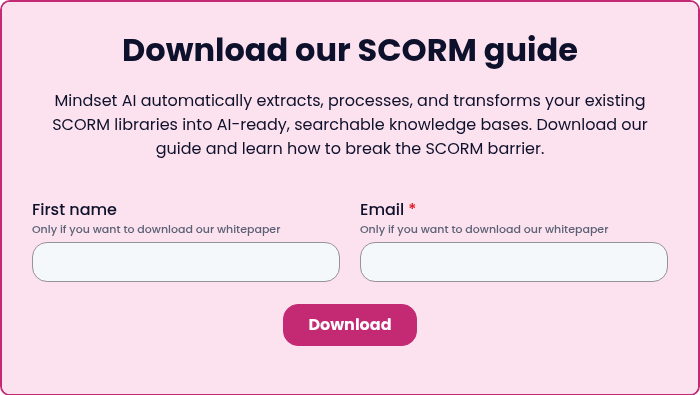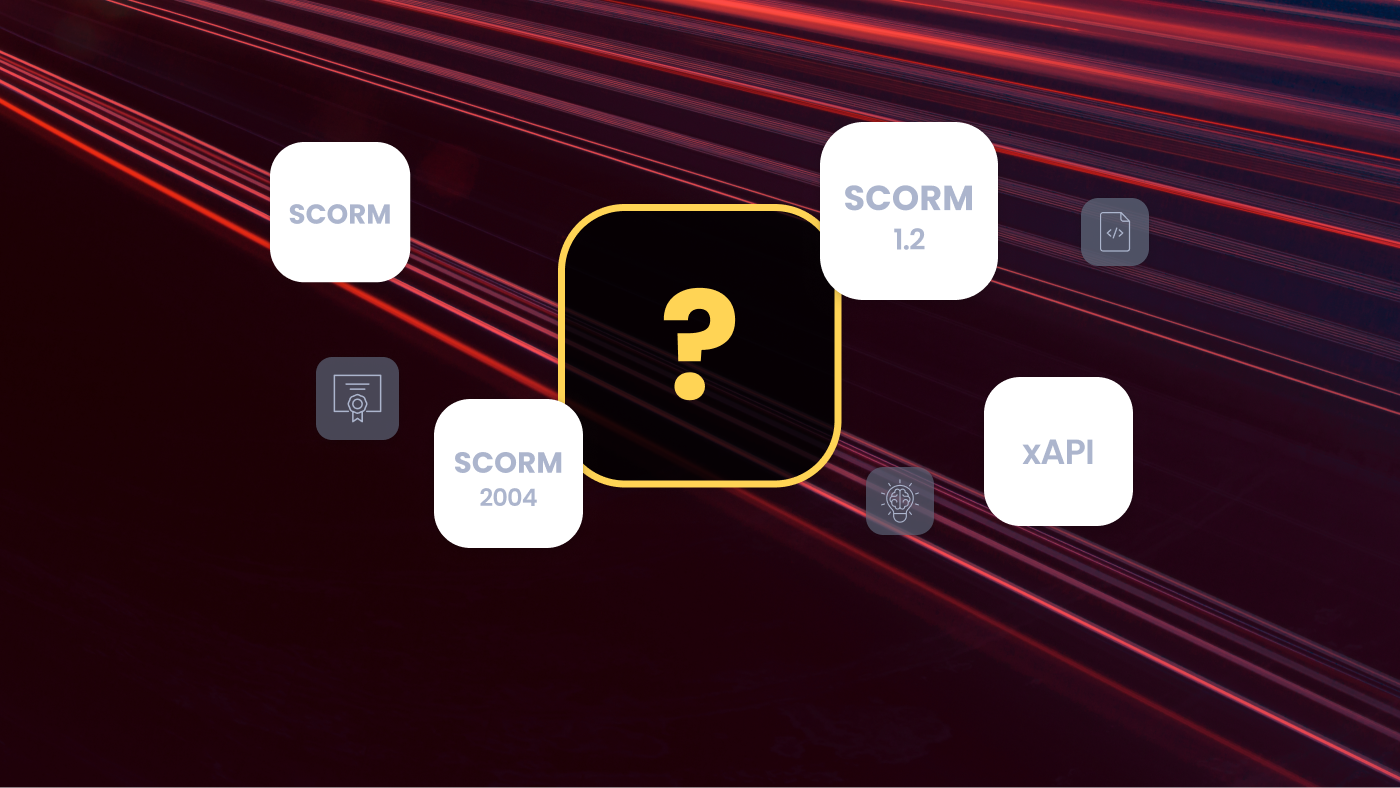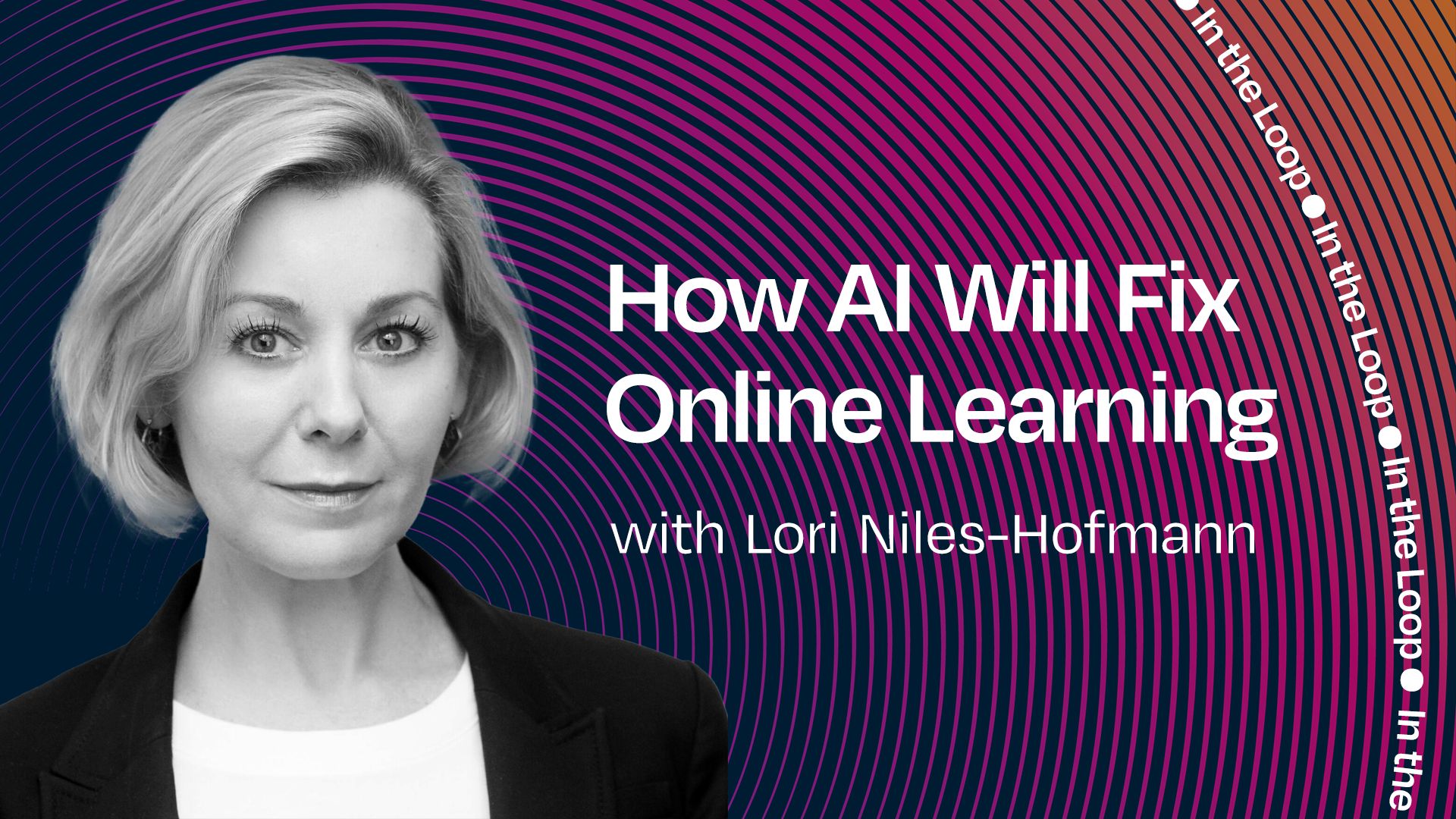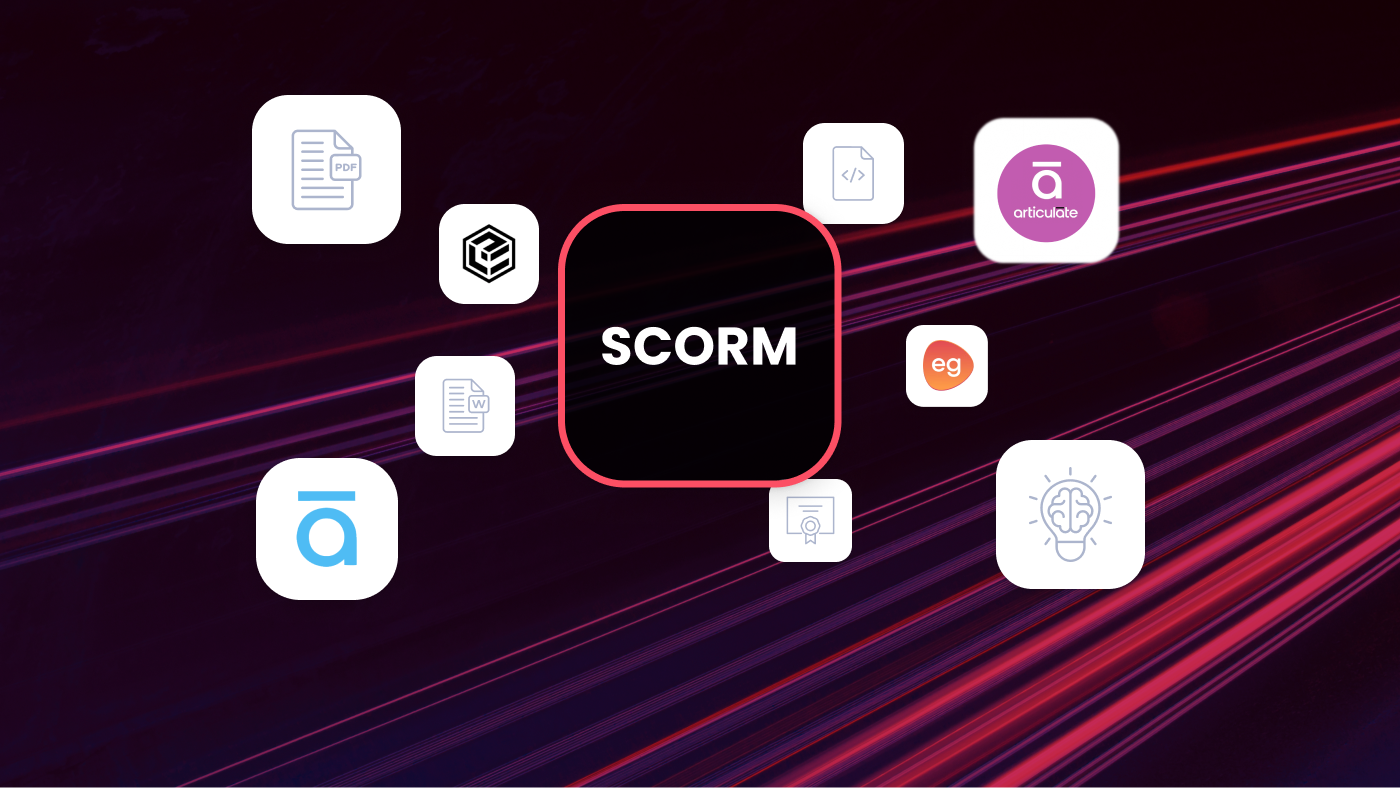What’s The Future Of SCORM With AI?

Published by
Published on
Read time
Category
"SCORM is dead." "Time to move on." "There are better alternatives now."
Here's the thing: while everyone's busy writing SCORM's obituary, the standard that powered e-learning for over two decades refuses to die. In fact, it's getting a second wind.
What's the future of SCORM? It's not the slow fade into obsolescence that many predicted. Instead, we're seeing something more interesting—a transformation powered by AI that's breathing new life into this veteran standard.
This isn't about nostalgia or resistance to change. It's about recognizing that sometimes the best path forward builds on what already works, rather than tearing everything down to start fresh.
Let’s take a brief look at the state of SCORM today and then dive into how fascinating the future of e-learning could be if SCORM and AI joined forces.
Do people still use SCORM?
You might ask: Is SCORM still relevant?
Recent statistics on SCORM usage are surprisingly scarce. Here’s what we do know:
According to a Software Advice survey, 62% of businesses use SCORM courses for training in their LMS. That's not a niche technology—that's mainstream adoption.
When it comes to version preferences, SCORM Cloud data shows about a 50/50 split between the number of SCORM 1.2 courses and SCORM 2004 courses. This distribution has remained fairly consistent over time, suggesting stable, ongoing usage rather than decline.
LMS vendors like Absorb LMS, TalentLMS, Docebo, iSpring, and dozens of others continue featuring SCORM support as a primary selling point.
Finally, SCORM is often the obligatory standard rather than a choice. SCORM remains the standard for compliance-based training in healthcare, finance, manufacturing, and government sectors. For example, the US Department of Defense's DoDI 1322.26 specifies that all content must be delivered via SCORM, xAPI, or cmi5. That covers millions of military and contractor personnel.
So it is safe to say that people still use SCORM, and it is still very much relevant.
Is SCORM depreciated? What needs to change?
SCORM works, but it's showing its age. The standard that powered desktop-based training for decades struggles with today's learning needs.
Limited analytics hold back insights
SCORM 2004 records overall progress and test scores, but it cannot delve into finer details like module completion times or revisitation of materials. You get pass/fail data, but miss the nuanced learner behavior that drives real improvement.
Modern L&D teams want to know:
- Which sections cause learners to struggle?
- Where do they spend extra time?
- What content gets skipped?
SCORM cannot collect detailed data on learner behavior and interactions, which limits your ability to analyze and adapt learning content.
Mobile learning friction
While SCORM can work on mobile devices with modern web browsers that support JavaScript, the experience often feels clunky. SCORM was designed for desktop consumption, and mobile learners feel that legacy. When 70% of corporate learners feel more motivated to consume professional development content on mobile, this is a significant disadvantage.e
Integration headaches
SCORM is a rigid and prescriptive standard that does not allow much flexibility or creativity in terms of content design, delivery, and assessment. It's also an isolated and self-contained standard that does not enable integration or collaboration with other systems.
What's replacing SCORM?
The industry hasn't stood still. Where SCORM only tracks desktop LMS activity, xAPI pulls data from multiple sources both on and offline into one place, a learning record store (LRS). This creates more complete data sets about where and how learning happens.
Meanwhile, cmi5 combines the launch structure of SCORM with the flexibility of xAPI—think of it as "xAPI with rules" for organizations wanting modern features with traditional control.
However, these technologies exist more to enhance SCORM than as full alternatives.
AI: The catalyst for SCORM's next chapter
Here's where things get interesting. AI has the potential to supercharge SCORM.
AI-enhanced content creation
AI-powered SCORM authoring tools are already changing how we build training content. These tools use algorithms to create personalized and adaptive online courses that are customized to each learner's needs and preferences. Instead of one-size-fits-all modules, you get content that adapts based on individual performance and learning patterns.
Tools like Mindset AI are leading this charge, using AI agents to create SCORM-compliant content that automatically adjusts difficulty levels and pacing. The result? Training that feels less like standardized instruction and more like personal coaching.
Smarter analytics from existing data
Remember SCORM's limited analytics? Mindset AI solves that problem without requiring you to abandon your existing content library. Machine learning algorithms can analyze the basic tracking data that SCORM does collect—completion rates, quiz scores, time spent—and extract meaningful insights about learner behavior.
AI and SCORM integration can help generate engaging and effective e-learning content while automatically tracking learner's progress to suggest personalized learning modules. You're not just getting pass/fail data anymore; you're getting actionable intelligence about how to improve both content and outcomes.
The bridge technology advantage
This is perhaps AI's most powerful role in SCORM's future: serving as a bridge between legacy systems and modern learning needs. AI can take your existing SCORM library and make it behave like next-generation training technology.
But this goes beyond just content. Thanks to protocols like MCP, A2A, and others, technology is becoming more accessible for AI agents every day. This means that adding an agentic framework on top of your SCORM library will allow for more rounded learning experiences across different software tools and platforms—including your traditional SCORM content, of course.
The future of SCORM: An EdTech leader’s vision
Let’s look at the bigger picture. We're not witnessing SCORM's funeral—we're watching its transformation.
Lori Hofmann, an EdTech and AI transformation strategist and the author of ‘The Eight Levers Of EdTech Transformation’ sat down with Jack Houghton, Mindset AI’s Chief Product Officer, to chat about the future of SCORM in the AI era. Listen to the interview on Spotify or wherever you get your podcasts.
Lori highlighted how SCORM had been created for learning compliance purposes to track whether employees completed training that was essential for correct business conduct, but soon it became the standard for all learning packages.
What SCORM doesn’t do is account for suspended learning, for examplewhen a person branches out of a course or learns something outside of the LMS (e.g., on Slack). There’s only so much instructional designers can do with a system like this.
Lori thinks that a big reason for the slow of innovation in e-learning and the stagnation of SCORM standards is due to the lack of financial incentive: what’s the ROI in helping employees learn better?
In Lori’s opinion, e-learning today sort of works like a fast food restaurant, where everyone can choose from the same menu and so get more or less the same product. Instead, e-learning should be like an emergency room where people get triaged and allocated the right pieces of training at the right time.
“Learning is going to be most effective and best when it is personalized to each individual. So we can’t say: this is the box all learning should go into—we tried to do that for a very long time.”—she says.
“What I’m looking at as really effective learning is one that is hyper-personalized to You. It knows you, what you’re working on, how your day has been, and how many meetings you had—and brings that all in context. Another thing good learning does is look at impact, and if there is none, it pivots the learning to something that will.”—she adds.
Personalization in the context of e-learning is thrown around a lot. But how does it actually look? Lori mentions Duolingo for their heavily data-driven and gamified approach to learning. Good learning is about giving real life opportunities to practice, re-iterate, and connect with a virtual coach to get one-on-one feedback. Most importantly, it breaks out of traditional, one-platform learning systems.
“Let’s say you’re learning Level 4 Spanish, so we know that your language skills are already pretty good. So next time you log into Slack or your other workplace apps, a message pops up ‘Hola! Do you want to change your language settings to get you even more hands-on practice?’ And then we measure how you’re getting on and eventually, the system will ask whether you would like to be connected with someone in Columbia who’s working on similar projects as you are. So now you can see that the person is probably still doing their basic language course—but with AI systems, we managed to embed language learning into their everyday work life.”
Lori’s not alone with this vision for platform-agnostic learning. EdTech and L&D leaders worldwide are having similar conversations—that’s why you’re reading this article too—and finally, with AI agents, this vision is becoming reality.
Conclusion: The AI-powered future of SCORM
SCORM isn't going anywhere. But it's not staying the same either.
The question "what's the future of SCORM?" has a clear answer: intelligent evolution, not extinction. AI is giving this 20-year-old standard a second life that's more powerful than its first.
Your SCORM library represents years of institutional knowledge, regulatory compliance, and proven training effectiveness. AI doesn't make that investment obsolete—it makes it infinitely more valuable.
The organizations that thrive in the next decade of corporate learning won't be the ones that chase every new technology. They'll be the ones that intelligently enhance what already works.
SCORM + AI isn't just the future of e-learning standards. It's the present for those ready to embrace it. Transform your SCORM library with Mindset AI—let’s get you started!
Book a demo today.




.png)
.png)
.png)
.png)
.png)
.png)
.png)
.png)
.png)

.png)

.png)

.png)
.png)
.png)

.png)
.png)


.png)
.png)
.png)
.png)
.png)
.png)

.png)
.png)
.png)
.png)
.png)
.png)
.png)
.png)
.png)


.png)
.png)
.png)

.png)
.png)
.png)

.png)
.png)
.png)



.png)






.jpeg)